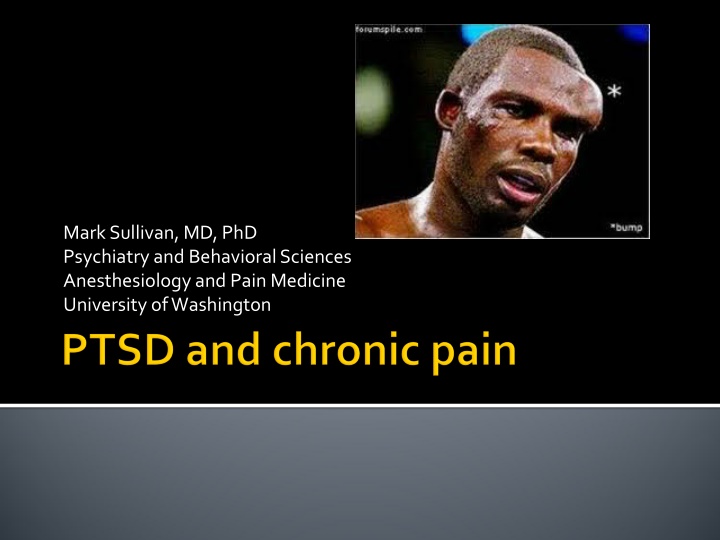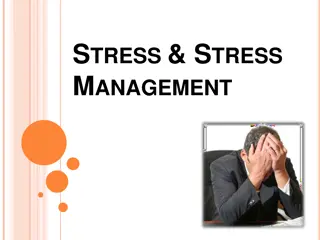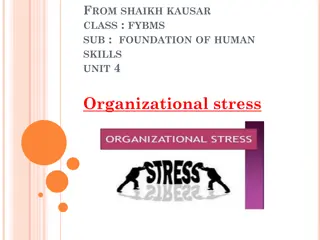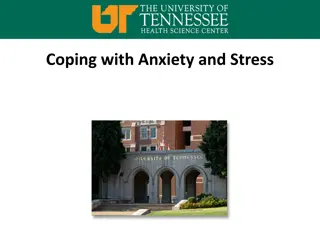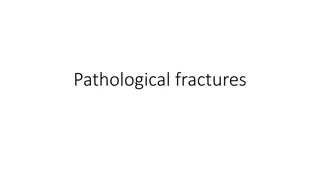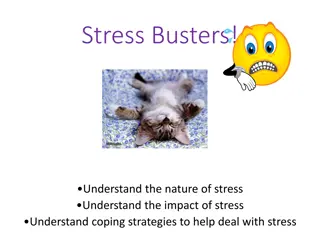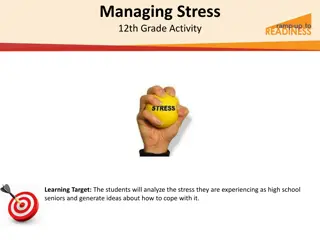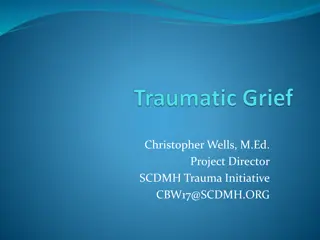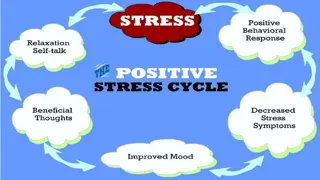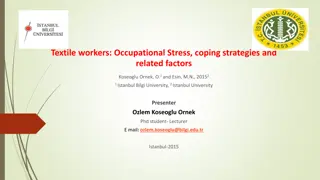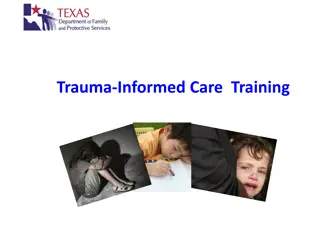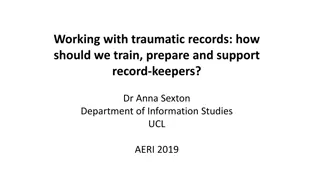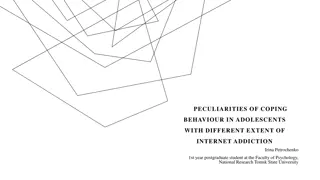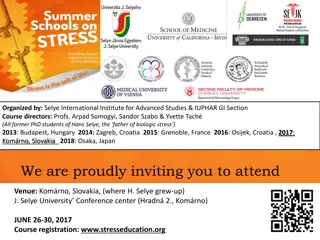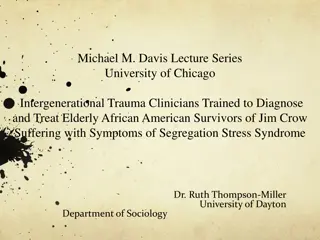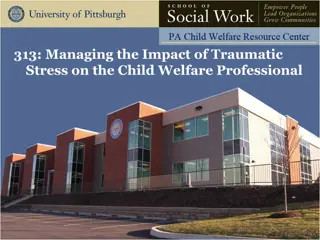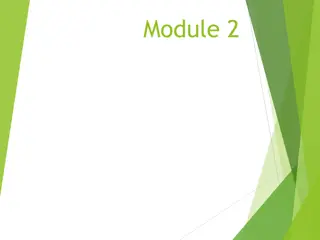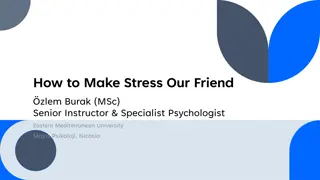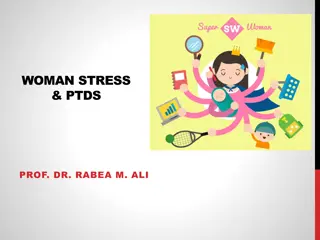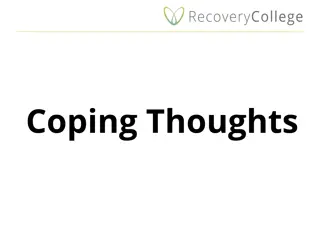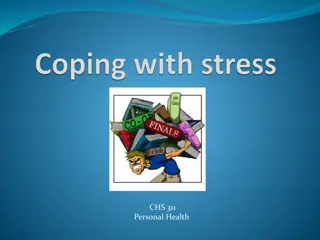Traumatic Stress and Coping Strategies
Traumatic stress can manifest through physical and psychological symptoms, impacting individuals' daily life. It can result from various traumatic events like accidents, violence, or war. Symptoms may include nightmares, emotional numbing, and increased startle responses. Coping strategies involve therapy, addressing negative beliefs, and avoiding triggers. Recognizing and managing traumatic stress is crucial for mental well-being and recovery.
Download Presentation

Please find below an Image/Link to download the presentation.
The content on the website is provided AS IS for your information and personal use only. It may not be sold, licensed, or shared on other websites without obtaining consent from the author.If you encounter any issues during the download, it is possible that the publisher has removed the file from their server.
You are allowed to download the files provided on this website for personal or commercial use, subject to the condition that they are used lawfully. All files are the property of their respective owners.
The content on the website is provided AS IS for your information and personal use only. It may not be sold, licensed, or shared on other websites without obtaining consent from the author.
E N D
Presentation Transcript
Mark Sullivan, MD, PhD Psychiatry and Behavioral Sciences Anesthesiology and Pain Medicine University of Washington
Physical Trauma Chronic Pain Overwhelming threat Risky behavior Psychological Trauma
Onset abd pain 29yr, diverticulosis with abcess, sigmoid colectomy 8/11 stabbed in RLQ by unknown man outside her apartment with superficial abd wound, bruises Current difficult divorce after loss of pregnancy, husband revenge? Denies earlier trauma, no memory of HS years during parental divorce
Nightmares of stabbing Increased startle response Avoids reminders and path outside her apt where stabbing occurred Emotional numbing and withdrawal
Experienced, witnessed, learned about, or repeated exposure to: Actual or threatened death Serious injury Sexual violence
Civil War: traumatic stress self-medicated with opiates and alcohol 1900 s: trauma reactivates childhood traumas and conflicts WW1: shell shock WW2: combat neurosis , concentration camp syndrome Vietnam War: PTSD
Exposure to traumatic event Threat: death, serious injury, integrity Response: intense fear, helplessness Traumatic event intrusions Recurrent, involuntary, distressing memories Recurrent distressing dreams of trauma Dissociative reactions (e.g., flashbacks) Intense distress at reminders Physiological reaction to reminders
Persistent avoidance of reminders Efforts to avoid associated memories, thoughts, feelings, Avoidance of external reminders like activities, places, people
Negative alterations in cognitions and mood Inability to recall important aspect of trauma Persistent negative beliefs about onself Persistent distorted cognitions regarding cause/consequences of traumatic event Diminished interest important activities
Negative alterations in cognition and mood (continued) Persistent negative emotional state (fear, horror, anger guilt, shame) Markedly diminished interest in activities Feeling of detachment from others Inability to experience positive emotions
Marked alterations in arousal and reactivity Irritable behavior and anger outbursts Reckless or self-destructive behavior Hypervigilance Exaggerated startle response Difficulty concentrating Sleep disturbance
From Kari Stephens PhD
PTSD symptoms emerge in 30% of those exposed to extreme stressors within days of the exposure, but usually resolve in a few weeks For 10-20%, PTSD symptoms persist w impairment in functioning 50% with PTSD improve without treatment in 1 year, 10-20% develop a chronic disorder
US Lifetime prevalence: 6.8% 12-month prevalence: 3.6% Vietnam veterans Lifetime prevalence:18.7% 12-month prevalence: 9.1% Iraq veterans: 12.6% Afghanistan veterans: 6.2%
39% of MVA survivors 39% of assault victims Injured workers sent for rehab 35% Fibromyalgia 20% curr., 42% life 35-50% of patients w PTSD have chronic pain In young adults, PTSD is the psych disorder most strongly associated with medically unexplained pain (Andreski et al. 1998).
Severe acute pain as traumatic Acute pain level predicts PTSD (Norman 2007) Mutual maintenance (Sharp & Harvey 2001) Chronic pain as reminder of traumatic event Perpetual avoidance (Liedl & Knaevelsrud, 2008) Re-experiencing triggers arousal, which leads to avoidance and pain through muscle tension. Perceived injustice (Sullivan et al 2009) Predict persistence of PTSD after whiplash injury
Re-experiencing Avoidance Arousal Pain Baseline .11 .10 .07 3 Month Re-experiencing Avoidance Arousal Pain .10 .09 12 Month .06 .05 .13 Re-experiencing Avoidance Arousal Pain Leidl et al, Psychol Med, 2010; 40:1215-23.
141,029 Iraq/Afghanistan veterans with chronic pain, ~10% opioid tx. 6.5% of veterans w/o MH disorders 11.7% with non-PTSD MH disorder 17.8% of veterans with PTSD higher-dose opioids, 2 or more opioids receive sedative-hypnotics concurrently obtain early opioid refills Highest rates adverse clinical outcomes Seal K et al, JAMA. 2012;307(9):940-947
Among indigent primary care pts, PTSD assoc w more pain, opioids All PTSD sx related to pain, impairment Only avoidance related to opioid use Among Af-Am MH patients, PTSD most strongly assoc w opioid use Violence exposure or PTSD predicts opioid abuse among teens
Severity of PTSD highly correlated with severity of opioid abuse Heroin (Dell Osso, 2014) Prescription opioids and sedatives (Meier, 2014) Medical cannabis and opioids (Bohnert, 2014) Prolonged opioid use after physical trauma (Helmerhorst, 2014)
Release of -endorphin in amygdala after stress inhibits overactivation of HPA axis Acute mu opioids after trauma decrease PTSD risk by inhibiting fear-related memory - opioids initially promote escape but then induce anxiety, depression, drug craving Chronic opioid use associated with avoidance cluster of PTSD symptoms, but not with improved pain, depression, anxiety outcomes
A. Bali et al. / Neuroscience and Biobehavioral Reviews 51 (2015) 138150
In your life, have you ever had any experience that was so frightening, horrible, or upsetting that, in the past month, you: 1] Have had nightmares about it or thought about it when you did not want to? YES / NO 2] Tried hard not to think about it or went out of your way to avoid situations that reminded you of it? YES / NO 3] Were constantly on guard, watchful, or easily startled? YES / NO 4] Felt numb or detached from others, activities, or your surroundings? YES / NO yes = positive screen Prins, A. et al (2003). The primary care PTSD screen (PC-PTSD): development and operating characteristics. Primary Care Psychiatry, 9:9-14
PTSD and chronic pain tend to improve together Track PTSD improvement with PCL-5 Available from www.ptsd.va.gov Track pain inteference With general activities With enjoyment of life http://www.health.gov/hcq/trainings/pathways/ assets/pdfs/PEG_scale.pdf
Psychotherapies (NNT<5) Exposure therapy (high) cognitive restructuring (CR) (mod) cognitive behavioral therapy (CBT)-mixed therapies (mod) eye movement desensitization and reprocessing (EMDR) (mod-low) narrative exposure therapy (mod-low) AHRQ Treatments for Adults with PTSD, 2012 report
Pharmacotherapies (NNT ~8) SSRI/SNRIs: fluoxetine, paroxetine^*, sertraline^, and venlafaxine* Anticonvulsant: topiramate* Antipsychotic: risperidone (low) Benzodiazepines: NOT RECOMMENDED ^= FDA approved *= best evidence for efficacy
Begin with simple grounding exercises and behavioral activation Effect sizes larger for psycho-therapies than pharmacotherapies Most treatment guidelines (VA, NICE) recommend psychotherapies as first line treatment Exposure + paroxetine superior to exposure alone in one trial
Dissociation can become a conditioned response What PCP s can do: Dangerous and dysfunctional for the patient Shut down immune functioning Educate Use/teach grounding skills orienting to the present through cuing to date, time, location, safety, physical, etc. Name 5 things you hear, see, feel, smell from Kari Stephens
Avoidance maintains PTSD symptoms What PCP s can do: Limits functionality Reinforces anxiety Increases pain interference Encourage behavioral activities to approach rather than avoid to unlearn fear and target functionality Start with VERY small targets (can be physical or mental), follow-up with patients from Kari Stephens
2 Top CBT Therapies Active Component Exposure Facing the trauma Facing the thoughts Facing avoidant behaviors Brief versions are being tried PE: Prolonged Exposure (Foa) CPT: Cognitive Processing Therapy (Resick) from Kari Stephens
Requirements for engaging Trauma Focused CBT: Iatrogenic Dangers: Exposure with no coping or avoidance prevention Repressed memories Exploring the past in psychotherapy Able to attend sessions Adequate support Trained provider available Adequate mental status from Kari Stephens
iPhone Android from Kari Stephens
Central a1-adrenergic receptor antagonist that reduces NE stimulation, startle, and nightmares of PTSD Proven in multiple small RCTs Multicenter RCT in VA underway Rapidly increasing use throughout VA Same short-term effectiveness as quetiapine, but better long-term
Begin 2mg qHS (1mg in frail) Increase by 2mg per week, to cessation of nightmares or 10mg Orthostatic hypotension, max on first night Often effective within first week May break through originally effective dose, but can recapture Doxazosin may work as alternative
Previous 3mo. EMDR therapy Venlafaxine 300mg Prazosin 6mg Oxycodone ~35mg/day Alprazolam 1mg qHS Engaged in Trauma-focused CBT Completed 4 sessions Continues to be employed
Physical and psychological trauma may contribute to pain chronicity, severity Pain and PTSD mutually reinforcing PTSD strongly associated w opioid use, abuse Use linked with PTSD avoidance symptoms
Psychotherapy is first-choice PTSD tx. Basic: grounding, behavior therapy Advanced: exposure, cognitive reprocessing Pharmacotherapy for PTSD can help Opioids and BZs promote dependence, avoidance SSRI/SNRI difficult due to arousal and anxiety TCAs, 5HT2 blockers useful Prazosin can be helpful
